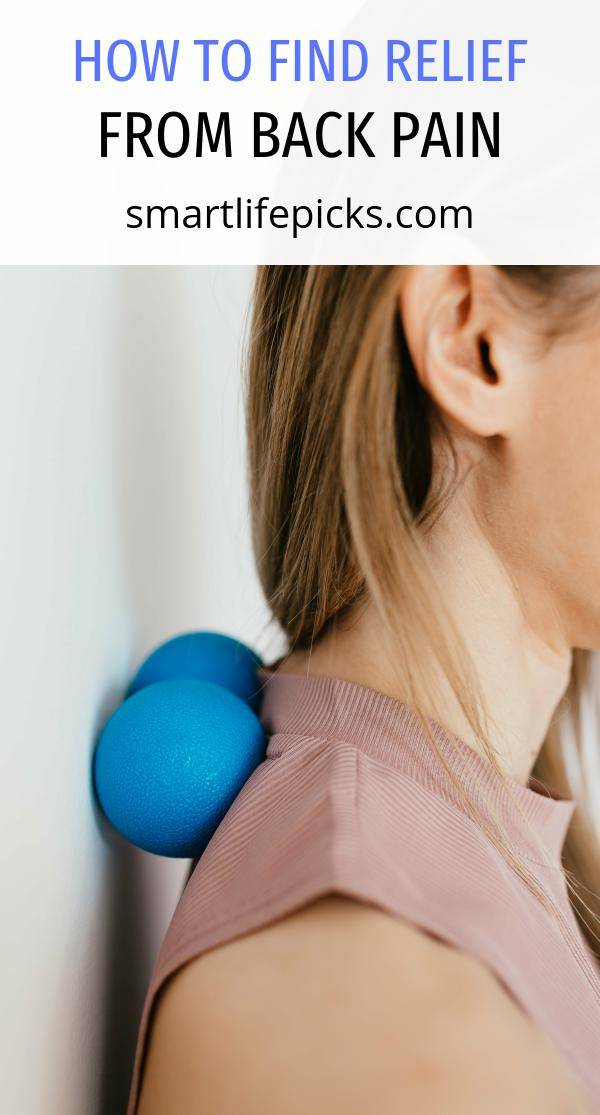How to Find Relief from Back Pain

Last Updated on September 27, 2021 by Smart Life Picks
There are a lot of causes for back pain. Some of the most common are sprains, strains, pinched nerves, and muscle tears. These are not just caused by muscle strain or tension, but by overuse or trauma.

Typically when an individual is dealing with back pain, it’s localized in either the lumbar spine region (lower back), or cervical spine region (neck). Your thoracic spine region (upper back), is generally far more durable and resistant to injury when compared to those two areas.
However, upper back pain is still a fairly common problem that many people experience. The most common symptoms associated with pain in the thoracic spine can include:
- Either sharp pain or an aching, general discomfort
- Stiffness
- Pain that radiates into your arm, chest, or further down your body
- Pins and needles sensations
People that experience upper back pain can find the symptoms either appear suddenly, or develop over a gradual period of time. Quite often, individuals report that the pain is intermittent — it’s severe early in the morning and then gradually improves throughout the day.
If you’re currently dealing with this type of pain, this article aims to provide you with a few tips on how to find upper back pain relief.
The majority of these causes may not be serious, but they can aggravate an already painful condition and lead to additional back problems down the road. You should see your doctor to determine what, if any, treatment is needed.

Exercise
One of the most common treatments for back pain is exercise. A variety of exercises can help relieve from back pain. Avoiding activities that cause more pain or pushing past it is not always possible, but certain activities can help. For example, specific exercises are designed to strengthen the muscles surrounding the back.
Correct posture
As this is by far the most common cause of back pain, it makes sense to begin with addressing any problems you may have with posture. Typical signs of poor posture include rounded shoulders, your head leaning forward, and are noteworthy for our purposes, body aches and pains.
Activity modification
If you notice that your back pain gets worse while performing certain activities or movements, then you might want to consider refraining from those tasks and giving your back some rest for a day or two. For example, if you experience noticeable pain while performing any household chores, then it’s best to hold off and worry about them later so as not to make things worse.
With that being said, it’s important to get back to an active lifestyle after a brief rest period. Prolonged periods of inactivity can contribute to your muscles weakening, which can potentially lead to more problems later on down the road.
Alternate hot and cold therapy
When you first begin to notice any symptoms of upper back pain, it’s a good idea to use ice therapy for the first couple of days. This can help to bring down any swelling and lower inflammation, helping to provide pain relief.
After the first 48 hours, it’s recommended to switch over to using heat therapy. While using both forms of therapy for back pain, there are two important considerations to keep in mind — don’t use hot or cold therapy for longer than 20 minutes at a time and periodically check your skin to make sure that you aren’t causing any tissue damage.

Massage therapy
Massage therapy is another way to treat the pain and get relief from Back Pain. Many people suffer from back pain when they have a heart attack or stroke. Massage therapy helps by lubricating the blood vessels and improving circulation.
There are certain types of arthritis that may cause pain in the lower back. In most cases, this is pain from inflammation in the spine. This type of pain is generally more acute and needs immediate treatment.
If you have a weak back, you may suffer from a condition called the sciatic nerve. This is pain felt on the outside of the leg near the knee.
Another cause of back pain is trigger point syndrome. Trigger point syndrome is basically a pain in the lower back. The nerve damage that occurs in this condition can be especially painful.
As a result of muscle injury, there is often swelling and redness in the lower back. This is caused by inflammation. While swelling may feel like a small lump, it is actually a piece of scar tissue.
A condition called lumbar stenosis, commonly known as a slipped disc, can also lead to back pain. This is usually caused by a herniated disc. It may also be caused by spinal degeneration, which is a gradual narrowing of the spinal column.
Other causes of pain in the lower back include degenerative disc or a bulging disc. Muscle strains slipped disks, or spinal stenosis can also cause pain.
Back pain has been proven to be a major factor in chronic pain. Finding relief from back pain can be difficult, but it is possible to get back the life you once knew.







